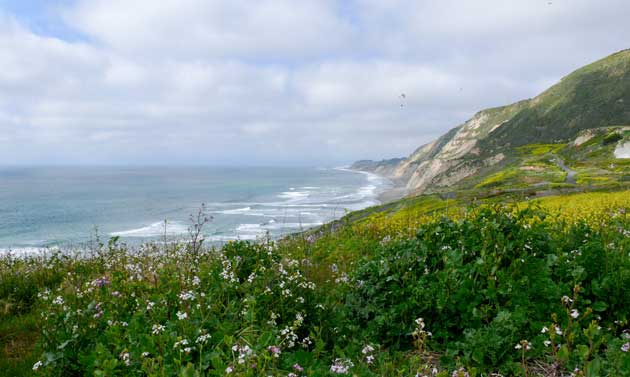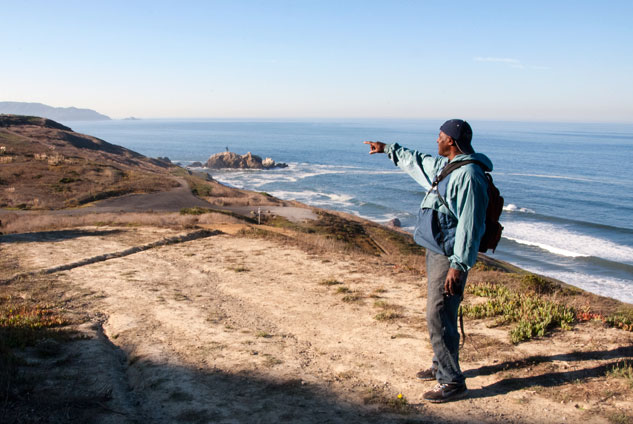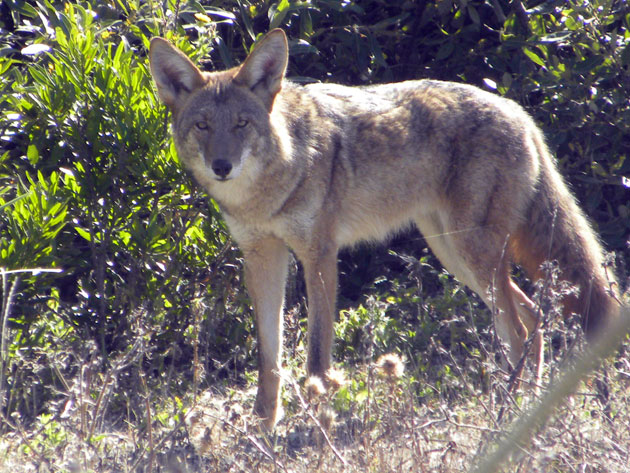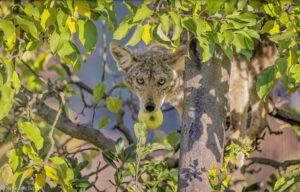
You go down, as John McPhee once wrote, through San Francisco’s Ocean View neighborhood to the first freeway exit after Daly City, where you describe, in effect, a hairpin turn to head north past a McDonald’s to a dead end in a local dump. You park the car and walk through a chain link gate, with a laminated poster that warns of coyotes in the area and, right next to it, a missing dog flyer. You walk through a field of ice plant on a wide gravel path along the contour of a ridge.
There, just up the cliff from where the San Andreas fault meets the ocean, the geologist doubles back west to observe the waves crashing on Mussel Rock; the dog walker and dogs scramble north on the open sand; and if you are Oscar Porter, every morning and evening you turn east, away from the beach, and hike into the pampas grass and toward the smell of the transfer station to look for something out of the ordinary.
“Some people go, ‘Gee Oscar, don’t you get bored?’” Porter says, as he stumps along a chalky sandstone trail on the bluff. “No, I don’t get bored. Every day is different.”
Porter cannot remember a time when he was not outside. He grew up in San Francisco, near USF, and explored around his home as a kid. After college he worked 10 years at the Janet Pomeroy Recreation & Rehabilitation Center, then 18 years as a counselor at San Francisco Juvenile Hall, then 10 years as a ramp serviceman for United Airlines, all while continuing to hike outdoors. His mother bought a house in Daly City, high on the hill overlooking Mussel Rock, and so Porter started walking in Mussel Rock Park. When his mother died he moved into her old house. He’s now been coming here so long there’s no point putting a figure to it – “Oh, shoot, 20 years or more,” he says.

To walk east in Mussel Rock Park, as Porter does, is to oppose the Earth. You don’t notice it as you stand there, surrounded by gently crumbling hills overhung with ice plant, but in aerial photos you can see the giant bite out of the cliff that geological accounts say is sliding inexorably into the sea. The second-largest active landslide on the California coast is moving slowly, at maybe 1-2 meters per year, but it is moving constantly nonetheless and has been for the last 100,000 years, and our ability to move uphill faster than it moves downhill may give the park a feeling of permanence that it does not deserve.
For more than 20 years, between 1957-1978, the landslide was a place to bury trash. Since the dump closed, according to a 2010 thesis by geology student Shawn Heiser at San Francisco State, Daly City has had to spend hundreds of thousands of dollars a year battling gravity, armoring the bottom of the uncapped landfill, building seawalls to keep the trash up and the ocean down. It is still one earthquake away, Heiser observed, from “certain local environmental calamity when the reanimated landslide could potentially eject an estimated 765,000 cubic meters of garbage from the buried landfill pits into the Pacific Ocean.”
Heiser also notes a “general disdain for the place itself by city leaders.” It’s one, he suggests, that people who use the park may not share. What’s under the ground is hidden, after all, while what’s above the ground promises all the wonder and excitement of nature.
For three years since his retirement Oscar Porter has walked through Mussel Rock Park almost every weekday, twice a day. Although he’s seen the park through two decades, it wasn’t until he started going every day that the coyotes showed up, and it wasn’t until more recently that he started taking pictures. He’s not sure why the coyotes came out, but he thinks they were probably there for a while and eventually became more willing to reveal themselves to him when they recognized him as a regular.

Grabbing his camera, he shows off an old close-up of a coyote staring at him with something like interest. “They let me do that,” he says. “It’s not me, it’s them.”
As he walks, Porter recalls coyote photos he’s taken. He pauses at a break in the ice plant, where a bush grows off the trail, to say this is the spot where a pregnant female emerged from the brush and into his camera viewfinder. He notes the hollow where the coyotes like to rest on hot days. Walking through overhead pampas grass, he pauses to point out where he once watched a hiker track into the park with a coyote trailing silently along behind.
He stops to rest in a small grove of lichen-dappled trees. He picks a leaf from a nearby yarrow plant, rolls it around in his finger and remarks on the spicy aroma. Although coyotes have been his main interest, photography inspired an interest in the wide range of flora and fauna of the park: He wonders what people do with the yarrow’s Chrysanthemum-like scent, why the delicate bluewitch nightshade plant seems only to grow in a certain spot on the sandstone bluff, and whether he ought to bring a piece of cardboard down next time so that he can have a uniform backdrop for perfectly capturing the glistening orb spider webs strung across the park’s marshy area. He once considered grabbing a large garter snake resting in the same grove, then thought better of it. A few years ago, he published an e-book of his nature photos called Nature Under the Fog; he’s also put a slideshow up on YouTube. “If I could get a shot, even an unusual plant or something out of the ordinary,” he says, “that’s a good day.”
The sun rises and Porter pushes out to a bluff-top lookout. Once, years ago, he hiked all the way north to Fort Funston, but then there was a landslide and the cliff washed out. He’s not sure when it happened; it was in the days when he had to work and didn’t visit the park every day. Now he drops his daughter off at school in the morning and goes straight for Mussel Rock. Sometimes he stays out until he picks her up again at 3 in the afternoon.
Long waves roll in and crash on the beach below. A kingbird perches on a nearby bush and lets fly with some light opera, and a pair of cottontail rabbits munches the scrub along the trail. Down below, the coyotes seem to have retreated into the shade for the day. Porter cups his hands over his eyes and looks back toward the bluff. He has a hammock, he says, and maybe someday he’ll come out and find a place to string it up.
“Maybe it’s my age,” he says, “I can just sit out here half the day.”




